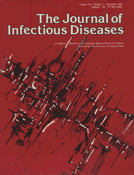-
Views
-
Cite
Cite
Thomas C. Quinn, Hugh R. Taylor, Julius Schachter, Experimental Proctitis Due to Rectal Infection with Chlamydia trachomatis in Nonhuman Primates, The Journal of Infectious Diseases, Volume 154, Issue 5, November 1986, Pages 833–841, https://doi.org/10.1093/infdis/154.5.833
Close - Share Icon Share
Abstract
To serially examine the immunopathogenesis and histopathology of rectal infection with Chlamydia trachomatis, we inoculated five cynomolgus monkeys with C. trachomatis serovar E (non-LOV) and five with serovar L2 (LGV). After inoculation, C. trachomatis was isolated from rectal cultures in three of five non-LGV-infected monkeys and in all five LOV-infected monkeys for a period of 10 weeks. LGV-infected monkeys developed a severe hemorrhagic ulcerative proctitis, in contrast to a mild proctitis in the non-LGV-infected monkeys. Hyperplasia of lymphoid follicles and a mucosal polymorphonuclear leukocyte and mononuclear cell infiltrate were evident in all infected monkeys. Crypt abscesses with giant cells and a rare granuloma formation were present in two of five LOVinfected monkeys. C. trachomatis inclusions were initially present in epithelial cells and later in tissue histiocytes, Experimental primate infection with C. trachomatis appears to clinically and histopathologically mimic rectal infection in humans and provides a model for immunopathogenesis studies in chlamydial proctitis and granulomatous proctitis.






